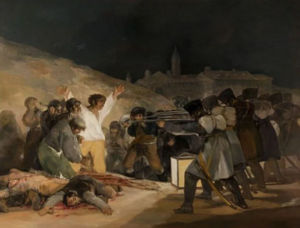Diferencia entre revisiones de «Francisco de Goya»
(Se ha añadido texto, imágenes y corrección al documento) |
(Se ha añadido referencias al documento) |
||
| Línea 9: | Línea 9: | ||
In 1816 Goya published Tauromaquia, a series of thirty-three prints illustrating the historical development of bullfighting and the feats of famous contemporary bullfighters. He created, from 1815 to 1824, the Disparates, a series of etchings related in mood to the Caprichos but larger in scale and more difficult to interpret; eighteen of the twenty-two plates in this series were published for the first time in 1864. | In 1816 Goya published Tauromaquia, a series of thirty-three prints illustrating the historical development of bullfighting and the feats of famous contemporary bullfighters. He created, from 1815 to 1824, the Disparates, a series of etchings related in mood to the Caprichos but larger in scale and more difficult to interpret; eighteen of the twenty-two plates in this series were published for the first time in 1864. | ||
[[Archivo:Captura.png|miniaturadeimagen]] | [[Archivo:Captura.png|miniaturadeimagen]] | ||
In 1819 Goya suffered a relapse of his illness and almost died. This traumatic experience is probably reflected in the fourteen Black Paintings | In 1819 Goya suffered a relapse of his illness and almost died. This traumatic experience is probably reflected in the fourteen Black Paintings<ref>''His late career culminates with the Black Paintings of 1819–1823, put on oil on the plaster walls of his home, the Quinta del Sordo (House of the Deaf Man), where he lived in virtual solitude, disillusioned by political and social changes in Spain.''</ref> | ||
<references group="Black Paintings" responsive="0" /> | <references group="Black Paintings" responsive="0" /> | ||
His late career culminates with the Black Paintings of 1819–1823, put on oil on the plaster walls of his home, the Quinta del Sordo (House of the Deaf Man), where he lived in virtual solitude, disillusioned by political and social changes in Spain. | His late career culminates with the Black Paintings of 1819–1823, put on oil on the plaster walls of his home, the Quinta del Sordo (House of the Deaf Man), where he lived in virtual solitude, disillusioned by political and social changes in Spain. | ||
Revisión actual - 14:34 10 ago 2023
Bibliography
Goya was born on 30 March 1746 in the small town of Fuendetodos near Saragossa to José Francisco de Paula and Gracia Lucientes. At the age of fourteen, Goya began a four-year apprenticeship in Saragossa to José Luzán, an undistinguished painter who had studied in Naples and was later a pupil, in Madrid, of the court painter Francisco Bayeu. On 25 July 1773, Goya married in Madrid Josefa Bayeu (The sister of Francisco Bayeu). Bayeu greatly assisted Goya's career by obtaining for him a position at the royal tapestry factory, for which Goya executed sixty-three cartoons by 1792 (thirty-nine of them before 1780). Goya published in July 1778 his first serious group of prints: nine etchings after paintings by Velázquez in the royal collection.
Near the end of 1792 Goya fell victim to a mysterious illness that incapacitated him for much of the following year, left him permanently deaf, and caused him to reevaluate his goals as an artist. Goya subsequently developed fantasy and invention into powerful social commentary in the Caprichos, a series of eighty etchings offered for sale early in 1799, but their sardonic criticisms of the existing social order made the prints controversial, and Goya quickly withdrew them from sale.
On 31 October 1799, Goya was appointed first court painter, the highest position available to an artist at the Madrid court. He executed several individual portraits of the king and queen between 1799 and 1801. Scholars have long debated whether the oath of loyalty that Goya swore on 23 December 1808 to Joseph Bonaparte as king of Spain signified genuine support for the Napoleonic regime, which had been established earlier that year in Madrid. Goya sympathetically portrayed many leaders of the French community in Madrid, but he later painted the duke of Wellington and others who worked for the liberation of Spain. The violence that Goya witnessed during the Spanish War of Independence (1808-1814) inspired him to execute the Disasters of War, a series of eighty-two etchings done between 1810 and 1820, eighty of which were first published in 1863.
In 1816 Goya published Tauromaquia, a series of thirty-three prints illustrating the historical development of bullfighting and the feats of famous contemporary bullfighters. He created, from 1815 to 1824, the Disparates, a series of etchings related in mood to the Caprichos but larger in scale and more difficult to interpret; eighteen of the twenty-two plates in this series were published for the first time in 1864.
In 1819 Goya suffered a relapse of his illness and almost died. This traumatic experience is probably reflected in the fourteen Black Paintings[1]
His late career culminates with the Black Paintings of 1819–1823, put on oil on the plaster walls of his home, the Quinta del Sordo (House of the Deaf Man), where he lived in virtual solitude, disillusioned by political and social changes in Spain.
- ↑ His late career culminates with the Black Paintings of 1819–1823, put on oil on the plaster walls of his home, the Quinta del Sordo (House of the Deaf Man), where he lived in virtual solitude, disillusioned by political and social changes in Spain.
which he executed about 1820/1823 in oil directly on the walls of two rooms in the country house on the outskirts of Madrid, popularly called Quinto del Sordo (house of the deaf man), that he had purchased in February 1819.
In 1824 Goya emigrated to Bordeaux, France, where he lived until his death on 16 April 1828.
